
Sunset Saturday October 3 - Sunrise Sunday October 4, 2009
Curated by Christof Migone
Part of SCOTIABANK NUIT BLANCHE at Hart House, University of Toronto (St. George campus)

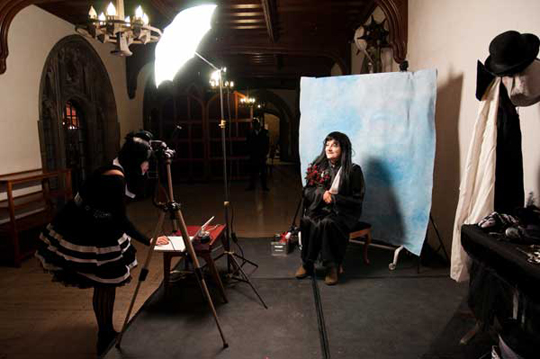
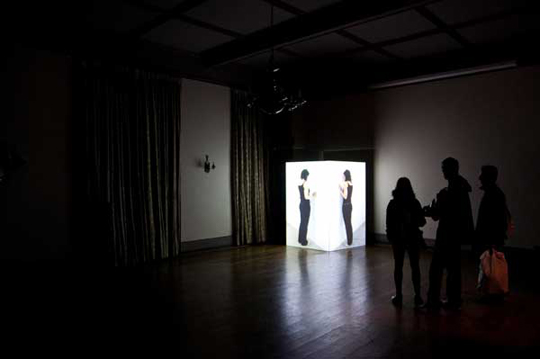

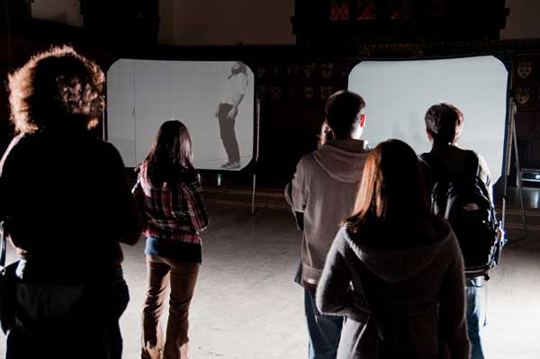
For art to succeed, its creator must fail.
Morton Feldman (1)
The carnivalesque context of Nuit Blanche offers an opportunity to investigate the potentially ominous and calamitous pairing of falling and failing with a light and irreverent touch. Drop Out hints at the plight of the student, and the 1960s phrase turn on, tune in, drop out. The predominant culture of success streamlines achievement to a narrow array of scenarios. Alternative modes of accessing knowledge and assessing merit are consistently marginalized. To drop out is to fall out of the normative, and into an outside. The countercultural movements of then and now persistently work against the predominant grain to forcefully facilitate a distinction between an act of failure and a failure to act. As metaphorical illustrations of these societal conditions some of the works featured (video, performance, sound, installation) will descend, while others will stay in seemingly perennial suspension. While works featured in Drop Out will often seem to dwell on the tangible and the concrete, they will also function as acknowledgments that to dropout (however momentarily) can also be a momentous event leading to a perspectival shift or an epiphanic state. Or, invoking the aforementioned failure aesthetic, they might merely aggregate into a series of futile attempts. The fact that to defy gravity confirms its vertiginous pull is the intrinsic paradox explored in Drop Out.
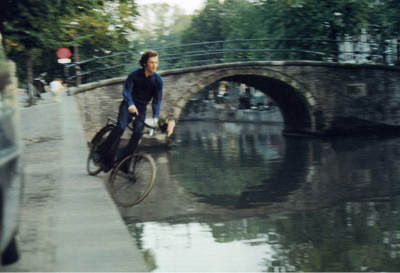
A selection of Ader's videos. A brilliant aphorism by Maurice Blanchot from The Writing of the Disaster eerily encapsulates Ader's entire oeuvre including his tragic demise: "To be lost, to capsize. Desire of the fall, desire which is the push and the pull of the fall. And whoever falls is not one, but several. Multiple fall. Each one restrains himself, clinging to an other, an other who is himself and is the dissolution—the dispersion—of the self, and the restraint is sheer haste, panicky flight, death outside death." (The Writing of the Disaster, trans. Ann Smock, Lincoln: University of Nebraska Press, 1995, 66).
Dutch/Californian artist Bas Jan Ader was last seen in 1975 when he took off in what would have been the smallest sailboat ever to cross the Atlantic. He left behind a small oeuvre, often using gravity as a medium, which more than 30 years after his disappearance at sea is more influential than ever before.
http://www.basjanader.com/
Video selection made by France Choinière for Dazibao (Montreal) on the occasion of the Gravity exhibition which presented a wide spectrum of works by Bas Jan Ader for the first time in Canada.
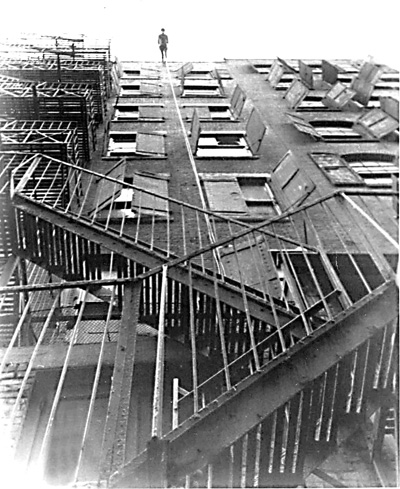
Mundane behavior shifted to the vertical axis. Walking as if not falling. This classic of what choreographer Trisha Brown has termed her 'equipment pieces' is more often seen only as a still photograph. Here the video of the original performance at 80 Wooster Street in NYC (which was recently recreated by the Tate Modern) will be presented. Trisha Brown describes the piece as "a natural activity under the stress of an unnatural setting. Gravity reneged. Vast scale. Clear order. You start at the top, walk straight down, stop at the bottom."
Trisha Brown first came to public notice when she began showing her work with the Judson Dance Theater in the 1960s. Along with like-minded artists including Yvonne Rainer, Steve Paxton, and Simone Forti, she pushed the limits of what could be considered appropriate movement for choreography thereby changing modern dance forever. This revolution in dance was imbued with a maverick spirit and blessed with total disrespect for assumption.
http://www.trishabrowncompany.org/
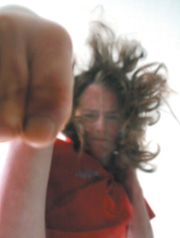
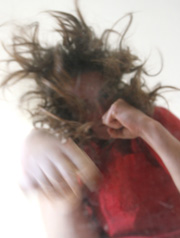
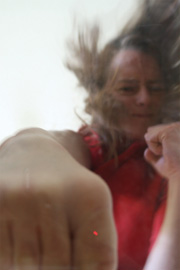
In the stop-motion video Knock Out, a woman awkwardly shadow boxes—as both recipient and perpetrator of fast-paced punches. The boxer's opponent seems to remain ambiguous as she fights either the viewer, the camera or the screen. A peculiarity emerges in the subject’s jerking and contorted motion due to the fact that the boxer fights with her feet rather then her fists.
Born in 1976, Jennifer Campbell grew up in Vancouver, B.C. She received a BFA-honours at University of Victoria (1998) and completed an MFA in photography at Concordia University (2004). Her work has been shown in solo shows at Dazibao, centre de photographies actuelles and Westspace (Melbourne Australia) as well as in several group shows in Vancouver, Seattle, Toronto, Montreal, and New York. She is currently working as the Director of Crawl Space Gallery, an artist-run centre in Seattle WA.
http://www.jennifercampbellphoto.com/
The Compulsion To Fill Space is a light installation consisting of a logo projection of the word STUPID in the interior space of Hart House. Used primarily as a promotional tool, I use a logo projector to display a word that has negative connotations, particularly when seen in a post-secondary institution. The aim of the piece is to reclaim the word 'stupid', so that STUPID becomes a positive affirmation. It is my intent to reclaim this reviled term into the realm of the positive. To look stupid is perfectly fine. In fact, it is a prerequisite for success in any undertaking. It is also an expression of the creative spirit, because creativity requires a leap of faith that could be a huge flop in the end. The title of the piece, The Compulsion To Fill Space, refers to the way in which logo projections take over the space in which they are shown. The title also references the fact that I am an artist of production; thus the constant creation of new works of art is my greatest concern, and it takes precedence over ideological or political concerns. As Dave Hickey puts it, “Content is irrelevant. I always tell my students, ‘Never forget you’re writing words! You know, word one, word two, word three, word four. The words have to be organized. Nothing else does.’"
Ulysses Castellanos is a multidisciplinary artist and independent curator living and working in Toronto. The central aim of his art practice is to demystify established cultural constructs by involving the viewer in the (often humorous) debunking of idealized images, concepts and paradigms. Castellanos culls images from films, television, literature and popular music and transposes these images within a performance art setting, or distills them into installations wherein these components are manipulated, juxtaposed, contrasted and collided against each other, with the aim of eliciting a shift in perception and understanding.
http://www.ulyssesdadabase.com/
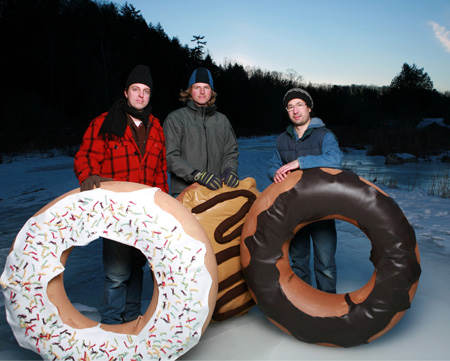
2x4 Ferris Wheel consists of off the shelf standard-sized lumber turned into a makeshift fantastical apparatus. The Ferris wheel will be used as an absurd delivery system for food and drink—a kind of vending machine that is more dreamy than functional. The Hart House courtyard will temporarily resemble the backyard of mad garage scientists.
Micah Donovan is an artist and educator. He has worked closely with Spiral Garden at Bloorview Kids Rehab, in Toronto, as a designer and arts program coordinator for children with and without special needs. He lives in Toronto. Christopher Martin graduated from the Rhode Island School of Design. His work has been seen in New York, Tokyo, Baltimore and Toronto. Born and raised in Toronto. Nobu Adilman’s career has so far included writing for network television (Emily of New Moon, Cold Squad), acting (Trailer Park Boys, Parsley Days), hosting CBC’s Smart Ask! for two years, guest hosting CBC’s late night program, ZeD, and pop culture reporting on CBC Newsworld’s >Play. He lives amidst the massive chaotic architectural reconstruction of Toronto, the city in which he was born.
http://www.foodjammers.com/
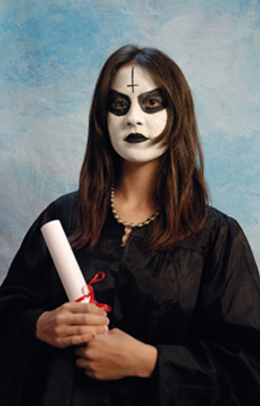
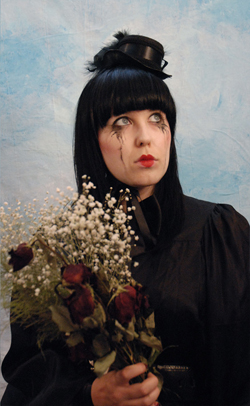
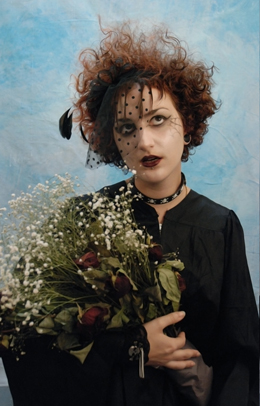
Cry School Yearbook is a collaboration between Gove, Kobayashi and Suddick where the artists will provide goth, metalhead and stoner makeovers to willing participants. The participants will then have their photographs taken in traditional graduation gowns. The portraits will then be assembled to create the ultimate yearbook of high school drop outs.
http://www.cryschoolyearbook.com/
http://www.asmk.ca/
http://emilygove.com/
http://www.jenniesuddick.com/
The F Papers will consist of a continuous reading of school papers which have received an F. At least that was the original idea, but we quickly found that an F graded paper is a chimerical entity—often the grade is given to a paper that failed to be written. What quickly became more interesting to consider was how a teacher would write what they would assess to be an F paper. Thus, two teachers have been commissioned to write papers for Goldsmith's project. Goldsmith's is renowned for his controversial notion of uncreative writing as creative plagiarism—a position which provocatively prods the standard grading scheme of educational institutions. Appropriately, The F Papers question and undermine the adulation for originality. The performance will simultaneously dismantle and praise the equations F is for Failure and F is for Fake (nod to the film by Orson Welles).
Kenneth Goldsmith's writing has been called "some of the most exhaustive and beautiful collage work yet produced in poetry" by Publishers Weekly. Goldsmith is the author of nine books of poetry, founding editor of the online archive UbuWeb, and the editor I'll Be Your Mirror: The Selected Andy Warhol Interviews, which is the basis for an opera, Trans-Warhol, premiered in Geneva in March of 2007. Kenneth Goldsmith is the host of a weekly radio show on New York City's WFMU. He teaches writing at The University of Pennsylvania, where he is a senior editor of PennSound, an online poetry archive. A forthcoming book of critical essays, Uncreative Writing, is forthcoming from Columbia University Press.
http://ubu.com/contemp/goldsmith/index.html
http://epc.buffalo.edu/authors/goldsmith/
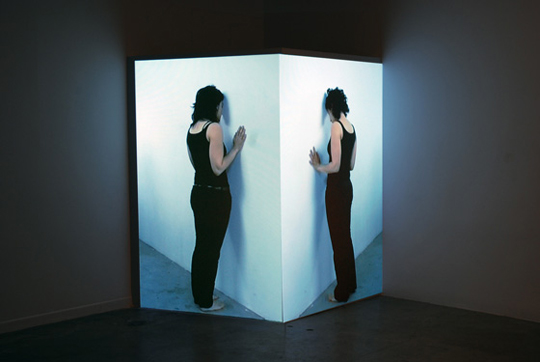
My Idiot is a video performance where two women each walk into a separate frame and repeatedly bang their heads onto the facing wall. The action continues for over six minutes. On the right side, the performer’s gesture is mechanical and robotic. On the left, she is exhausted and in agony. Inspired by the suicidal tendencies of the Philippine tarsier, a primate who (when in captivity, should they become depressed) ends its life in one of three ways: drowning itself in its water bowl, starving itself, or by banging its head on the wall until it drops dead.
Erika Kierulf is a Montreal-born visual artist who completed an MFA at Concordia University in 2007. Her photographic and installation work has been shown in Canada, Sweden, and Mexico. Concerned with issues of intimacy and the banal, she explores emotional and bodily states of in-betweenness.
http://erikakierulf.com/

This is my 30th year of skydiving, the anniversary of my first jump is September 29th. I made my first jump in Gananoque in 1979 while studying sciences at Queen's University. I was only 17 and lied about my age to sign the waiver so I could take my first jump course. As of July 21, 2009, I had 1688 jumps.
Photographer and multimedia performance artist Paul Litherland lives in Montreal and performs at Multimedia Art festivals and events. His work incorporates ideas of risk taking, finding strengths in unexpected places and creating artworks with a sense of humour. Media and ideas he works with include digital photography, digital video, performance art, base jumping, skydiving, boxing, street interventions, vulnerability as strength, exposure to risk, and poetic combinations of materials and histories.
http://paullitherland.com/
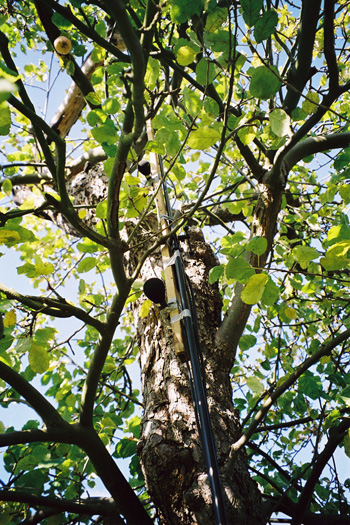
Recordings from Sir Issac Newton's Apple Tree, Woolsthorpe Manor, Lincolnshire, England, October 18, 2003.
If one opens a German-English dictionary to the term ‘Fallobst’, one finds a word that encompasses everything contained in this recording: ‘windfall’. This word, in English, is not only used to denote ripe fruit that has fallen to the ground, it also describes ‘an unexpected stroke of luck’.
It must be several years ago now that my wife and I found ourselves wandering through a pear orchard in the village of Kehrsiten on the Vierwaldstatter Lake near Lucerne, Switzerland. Enveloped by the darkness of night and undisturbed by surrounding noises, we listened to the sound of ripe pears as they fell to the ground—a sequence of events of surprisingly remarkable sounds and structures. It was also an ‘unexpected stroke of luck’, because in these abrupt and unpredictable events of concentrated density, I could recognize everything that engages me as a sound artist and composer: creating an energy of attentiveness that is indeterminate and unpredictable in the Cagean sense, yet which retains a narrative, metaphorical overtone. It would be exaggerated to identify a matrix of my sound art in the pear orchard and its aural outcome, but in any event, it is an ‘unexpected stroke of luck’ to listen to the noise of the falling fruit and to find pleasure in it: the sudden rustling of branches as the fruit falls through them, followed by the sound of its impact, a dull thud in the damp grass of the night. Here, the static (the motionless tree) meets the dynamic (the falling fruit). The process ripening of the fruit also fascinates me: this ‘little bit too much’, the extra few cells which have been enriched with water, making the fruit too heavy to be held by the branch, the maturation, reached at some point in time, which lets the pear or apple fall.
In 1998, I read what for me appeared to be a sensational news item: an apple tree under which, according to legend, Sir Isaac Newton made his observation of the famous falling apple, has been scientifically demonstrated to still exist. In Contemporary Physics, R.G. Keesing published the article The History of Newton’s Apple Tree (An investigation of the story of Newton and the apple, the history of Newton’s apple tree and its propagation from the time of Newton to the present days). Ever since reading this article, I planned a sound installation using recordings of apples falling from Sir Isaac Newton’s famous apple tree.
It was ‘an unexpected stroke of luck’ that Nicolas Collins sent me the Call for Silence, and so, from October 17 to 19, 2003, I traveled with my colleague and former student Oliver Friedli to the Woolsthorpe Manor in Lincolnshire, Newton’s place of birth, to record apples falling from the original tree in surround-sound. The birth house lies nestled in an almost forgotten, picturesque landscape, with its fruit orchard, free-range chickens (all descended from Newton’s time) and bleating sheep of a rare species. The atmospheric impression is however dreadfully clouded by an incessant, ubiquitous noise; if only Highway A1 were not in the vicinity! Hardly more imaginable is what William Stukley noted in his diary on the occasion of a visit to Newton in 1725/6: After dinner, the weather being warm we went into the garden and drank thea, under the shade of some apple branches, only he and myself. Amidst other discourses, he told me that just in the same situation, as when formally the notion of gravity came into his mind. It was occasioned by the fall of an apple, as he sat in a contemplative mood.”
Despite the omnipresent noise, I decided to use only original recordings from these environs for this production. Noise is a daily reality and if one listens into its internal structures, one might also discover some fascinating sound processes.
I am especially grateful to Susan Haimes, Property Manager of Woolsthorpe Manor, and her colleagues who made the recordings at this historic monument possible in an unconventional and uncomplicated way. Also unforgettable is the English tea that was served to us beneath Newton’s apple tree.
With support from the Hochschule der Kunste Bern, Department of Music and Media Arts. English translation: Laurie Schwartz. Sound design: Oliver Friedli.
Valerian Maly, born in 1959, lives in Bern (Switzerland) and works in the fields of inter-media, performance, installations. He studied Music at the Music Conservatory in Luzern. He is professor at the Hochschule der Künste Bern (HKB), teaches History of Media Arts, Performance Arts & Performing Arts.
http://www.medien-kunst.ch
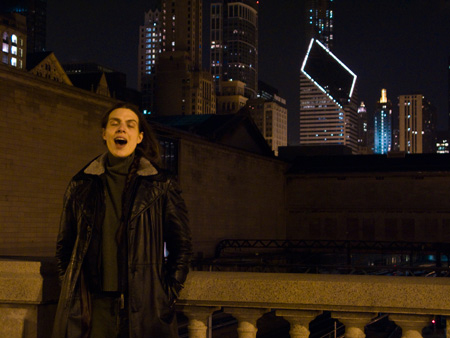
How does one measure the value of a song when the singer sings it again and then again in a presentation that might only be interpreted as self-corrective—falling and failing the horizon of perfection? In Pivato's 12-hour a cappella performance of I Fall to Pieces, can the exquisite, melancholic hold of Patsy Cline's iconic ballad, be born again as something we hardly recognize but still want?
My training as an artist began in the performance traditions of theater and classical singing. As a performer, my experience within the rehearsal process cultivated in me an interest in the performer-audience relationship specifically regarding the transmission of meaning and affect. In the Comfort Songs series I create endurance performances of iconic female power ballads. Through repetition I use the semiotics of performance as a technology for transformation: the ephemeral transaction of emotive performance becomes stabilized, flattened out, suspended beyond temporal limitations. In this communication through physical action, performer vulnerability enables me to situate myself with the viewer in the rupture that ultimately materializes between expectation and experience.
Juliana Pivato has recently completed an MFA in Sculpture at School of the Art Institute of Chicago. Juliana studied in Studio Arts at Concordia University in Montreal [BFA 2006], Classical Voice at McGill University in Montreal with Jan Simons [BMUS 1998], and at the National Theatre School of Canada [93-95]. Juliana works in a variety of media including performance, bronze casting, drawing, video, sound and new media installation. Since 2008 she has been hosting a weekly radio show on freeradiosaic.org entitled Songs from the Loop.
http://www.julianapivato.org/
http://90littlecarpenters.blogspot.com

A car hangs portentously in midair, arresting a clichéd mini-climax in an action movie. The viewer can only guess as to what events led to its peculiar suspension, likewise they have no idea if it will ever plummet to the earth below, but in this “in-between” state lies an uneasy calm.
Kelly Richardson studied fine art at the Ontario College of Art & Design (AOCAD with honours) and media studies at the Nova Scotia College of Art and Design (MFA studies). Her works have been exhibited internationally at various venues including the Sundance Film Festival, USA (2009), Busan Biennale, Korea (2008), Hirshhorn Museum and Sculpture Garden, USA (2008), HALLWALLS, USA (2008), Le Mois de la Photo a Montreal, Canada (2007), The Nunnery, UK (2006), Northern Gallery for Contemporary Art, UK (2005), Gwangju Biennale, South Korea (2004), Stills Gallery, Scotland (2004), Art Gallery of Ontario, Toronto (2002-2003) and Centre Georges Pompidou, Paris (2002). Her work was recently acquired by the Albright-Knox Art Gallery (Buffalo, New York), Musée d'art contemporain de Montréal (Montréal, Canada) and the Hirshhorn Museum and Sculpture Garden (Washington DC, USA). Current and near future exhibitions include Art Gallery of Nova Scotia, Halifax (April 11-May 31), Musée d'art contemporain de Montréal, Quebec (May 6-June 20), 126, Galway, Ireland (July) and Confederation Centre of the Arts, PEI (June 6-September 26). She lives and works in the United Kingdom.
http://kellyrichardson.net/
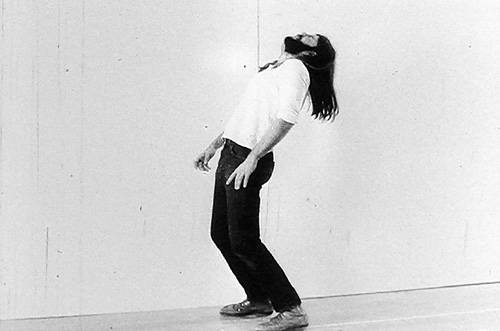
Tom Sherman, Hyperventilation piece (1970). Photo credit: Andrew Lugg.
The video recording of Sherman’s first performance of Hyperventilation piece (1970) was lost shortly after he moved to Toronto in 1971. Drop Out will feature Sherman reperforming Hyperventilation piece for Andrew Lugg's 1972 film "Trace". For the Fall Out exhibition at the Blackwood Gallery, Sherman will present a text version of the piece (included below).
I was hanging around Ypsilanti, Michigan, having finished my BFA degree in sculpture at Eastern Michigan University. I was 23 years old, bean-pole thin and had shoulder-length straight dark brown hair and a full black beard. I had met John Orentlicher who had just joined the faculty. John said he heard I might be interested in working with video equipment. He told me he had booked some video gear for over the Christmas break, December 1970, and if I was interested, we could experiment with video.
I said I wanted to document a performance in which would hyperventilate until I passed out. I had never hyperventilated until I blacked out but thought it was possible. We set up a camera on a tripod at chest height. I taped a line on the floor with its far end about ten feet from the camera. It formed a 'runway' toward the camera and had perpendicular strips of tape at one foot intervals. I stood at the far end of the line, facing the camera, and had John frame me so I was in the shot from the waist up. Then he started recording, I became still, concentrating while I looked directly into the camera, and then began to inhale and exhale the deepest breaths I could.
According to the plan, at one minute into the exercise John called out “one” and I took one step closer to the camera. After two minutes John called “two” and I advanced another foot closer. By about the four minute mark I was beginning to feel spasms rippling through my abdominal muscles and my arms and hands were curling in at my sides. By the fifth minute I was labouring hard and my breathing was a hoarse roar, and beside the contractions in my torso I was drooling thick strings of saliva. I was getting light headed but the burning intensity of the exertion was keeping me grounded. I just kept pushing hard to hyperventilate myself into oblivion and eventually found myself on the floor looking at the ceiling. I had fallen completely out of the frame at six minutes and forty seven seconds. My legs had buckled and I had hit my left hip and the back of my head on the floor before I had come to a rest.
Watching the playback of the recording, I was in a close-up by the time John had stopped counting at five minutes, as planned. I was heaving in and partially out of the frame with each convulsing breath. On the tape you could see my eyes roll back into my head as I spun out of the frame and went down. The camera showed only the wall behind me as the video camera’s microphone recorded the percussion of my collapse and continued to capture heavy breathing from the floor. There was some relief in the respiration as I was gasping for breath from outside the frame. John let me lie there for the couple of minutes before I pulled myself up.
I carried the ½ inch reel-to-reel video recording of my hyperventilation performance around with me for a couple of years and showed it to interested parties in private screenings here and there. It was lost shortly after I moved to Toronto in the fall of 1971.
Founding co-editor of Fuse magazine, Toronto, 1980; represented Canada at the Venice Biennale 1980; founding Head of Media Arts section of the Canada Council for the Arts, Ottawa 1983-87; international commissioner for Venice Biennale 1986; appointed director of the School of Art and Design, Syracuse University 1991; co-founded Nerve Theory, an international performance art/recording collaborative 1997; awarded the Bell Canada prize for excellence in video art 2003.
http://transmedia.syr.edu/sherman